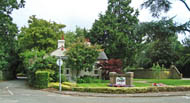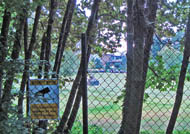Convalescent
Fund-raising for a convalescent home for post-operative patients from London 'probably somewhere in Surrey' was started in 1903 by Miss Etheldred Fraser-Tytler and others. The initial aim was to create an endowment of £30,000 which, it was hoped, would produce an income of about £1200 per annum, and then to raise more funds for the purchase of a suitable property and the necessary equipment.
In 1910, when between £30,000 and £40,000 had been subscribed, Sir Ernest Frederick Schiff, of Carlos Place, contributed £132,000 towards the project as a memorial to his brother Alfred. This generous donation enabled Knowle Hill Park in Cobham to be purchased. This house stood in 48 acres of grounds and, once a new wing had been added, could accommodate from 70 to 75 patients.
The home was to be managed under a Charity Commission scheme. The managing committee was comprised of appointees of the London general hospitals, members who had been elected by those who had donated £5 or more (mainly from London) , and co-opted members. The Chairman of the committee was the Earl of Lytton.
The Schiff Home of Recovery opened in November 1910 and initially received patients from six London teaching hospitals - Charing Cross Hospital, King's College Hospital, the Middlesex Hospital, St Thomas' Hospital, University College Hospital and the London Hospital. It provided accommodation for surgical patients recovering from accidents or operations who were not well enough to return to their normal activities, but did not need much nursing care, thus freeing up acute beds in the general hospitals.
During WW1 Sir Ernest placed 21 beds at the disposal of the War Office and it became a 'Hospital for the Wounded' - the first hospital outside London to receive wounded soldiers. The Home was classified as Class B and was affiliated with the Horton (County of London) War Hospital on 28th September 1915. Two further wards were added in 1918, creating an extra 40 beds. The military section of the Home closed on 2nd October 1919.
In 1948 the Home joined the NHS under the control of the Epsom Group Management Committee, part of the South West Metropolitan Regional Health Board. It continued to receive convalescent post-surgical patients from the London teaching hospitals, as well as from Surrey. It had 80 beds, of which 55 were open in 1948 and 51 in 1949 (because of lack of nursing staff). Patients stayed on average for 20 days.
The grounds contained a large kitchen garden, which contributed produce towards meals for the patients and staff. Poultry were also kept.
By 1954 the Home had 84 beds, with an average occupancy of 72 (86%). Patients stayed on average for 19 days. The weekly cost of an in-patient was £9 8s 0d (£9.40).
In 1954 a new Physiotherapy Department was built, but it was decided to close the operating theatre, as it was used only infrequently by surgeons from the South London Hospital for Women. However, it was retained for emergency use only.
In 1959 the average bed occupancy was 81% and the weekly cost of an in-patient had risen to £17 3s 7d (£17.18).
In 1960 the Home celebrated the 50th anniversary of its founding. It was decided that the running of the market garden and the poultry farm was uneconomic. The 5-acre site was leased for a privately run market garden.
In 1965 there was a 76% bed occupancy. The weekly cost of an in-patient had risen to £24 1s 3d (£24.06).
In November 1969 the Home came under the control of the Epsom and West Park Group Hospital Management Committee, which was formed of the Epsom Group and West Park Hospital Management Committees.
The Home closed in 1980 and the property was
sold to the Wellcome
Foundation.
Present status (August 2009)
Knowle Hill Park is now the headquarters of Cargill, the international commodity traders.


The main entrance to Cargill. The road markings state 'Private Property'.

The house is barely visible through the security fence from Water Lane.

The old east drive is now a private road, 'The Stables'.
(Author unstated) 1910 Reflections from a Board Room Mirror. British Journal of Nursing, 29th January, 93.
(Author unstated) 1914 The care of the wounded. British Journal of Nursing, 12th December, 470.
Lord JR 1920 The Story of the Horton (County of London) War Hospital, Epsom - Its Inception and Work and Some Reflections. London, Heinemann.
http://query.nytimes.com
www.bbc.co.uk
www.edlhs.co.uk
www.exploringsurreyspast.org.uk
www.facebook.com
www.flickr.com
www.francisfrith.com (1)
www.francisfrith.com (2)
www.kentvad.org
www.scarletfinders.co.uk
www.stamps-auction.com
Return to home page